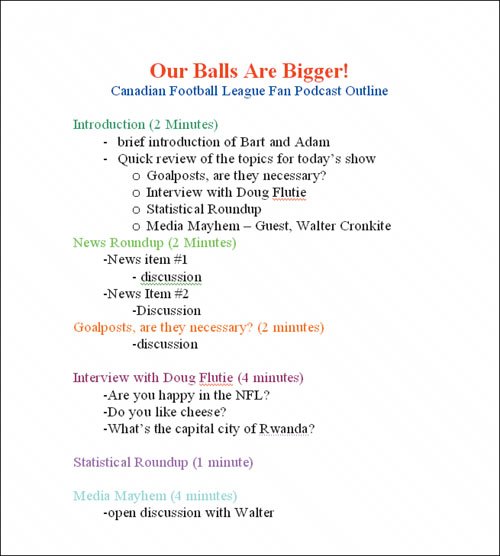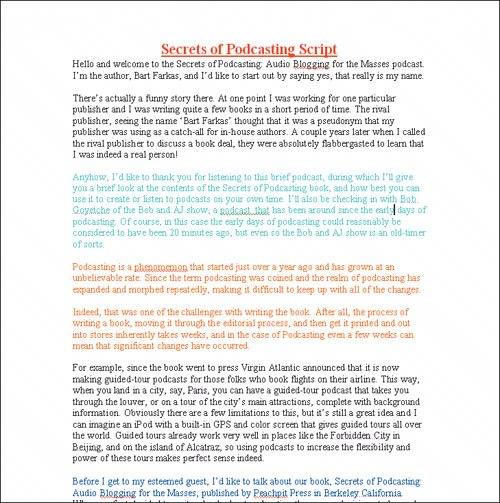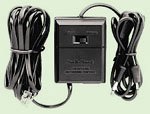Before the Podcast
| This section deals with everything relating to the creation of podcast content, from outlining a show's content to booking guests and formulating questions for them. Although it is possible for a podcaster just to pick up a microphone and create a "show," it requires a much larger effort to ensure that the podcast sounds professional while being a compelling listen. In this section, you see what you can do before the tape is rolling to maximize the quality and enjoyability of your podcast. Some podcasts are clearly created by the seat of the host's pants, with little regard to a structure or plan for entertaining or educating the listener. But the "amateur" moniker that is attached to podcasting doesn't mean that the content of podcasts needn't be professional.
With a little bit of background work, one can turn amateur hour into something that is respectable and highly listenable. There are four key elements to a successful preproduction process for a podcast:
This section details the creation of an audio podcast, but most of the same principles apply to video podcasts. Check out Chapter 4 for information on creating video podcasts. Mission StatementThe first thing to do is write a mission statement or design document that sets out rules for the tone and overall structure of the show. This document should spell out the boundaries of taste with regard to language, touchy topics (politics, abortion, favorite ice creams), and the overall attitude the host(s) should exhibit. Although this process may seem rigid for an amateur podcast, the act of going through it goes a long way toward solidifying the overall feel of the podcast in your mind. Remember, this document is not set in stone; you can change it as much or as little as you want. The important thing is to establish the ground rules before you get your pearly whites in front of the microphone. Knowing the general rules allows the host to be more natural and to enjoy the process rather than sweat over the appropriateness or validity of everything he or she is saying.
Topics, Guests, and Show LengthI'm guessing that you've already established an overall concept for your show, but even though you think "Foot Care for Firewalkers" is a fascinating theme for a podcast, you still need a topic for the first show. I strongly suggest that you choose a topic for the show and stick to it, keeping as much of the content centered on the theme as possible. If you title your podcast "Navel-Gazing for Experts: To the Hole and Back," be sure to stay focused on the topic throughout. People who "tune in" to the podcast have done so because they have read the title and synopsis of the podcast. It is likely that listeners will be disappointed if the podcast strays too far from the announced concepts. It is advisable to make a reference list of related topics so that in the heat of the podcast, you can keep the show on track with just a glance or two at the topic list.
Next up, you need to choose who, if anyone, will be a guest on your show. Guests are fantastic; they provide instant content, and you can bounce ideas and humorous anecdotes off them. The important thing to remember when getting a guest for your podcast is to have at the very least a crude list of questions before the podcast begins. A guest might be a good friend whom you can chat with for hours, but once the mikes are on, it's a different ball of wax. Having a nice list of eight or ten questions at the ready will ensure that even if your stressed-out mind draws a blank, the show will go on! Last, you must decide on a length for the show. Initially, shorter is better; you would be surprised how hard it can be to fill even one half-hour the first time you attempt to create a podcast. OutlineNow that you know what the podcast is about, what the tone of the show is, and how long the podcast is, it's time to put together an outline that breaks the show into segments no greater than 5 minutes long. As shown in Figure 3.5, the outline should be set up in such a way as to help you fill every minute of your podcast with entertaining and/or interesting content. Figure 3.5. An outline is a valuable tool to help keep you on track during a podcast. If your outline for a 20-minute show is broken into two 10-minute segments, there isn't much point in constructing it. On the other hand, if the outline is broken into 10 two-minute segments, the flow and content of the show will be easy to maintain. Even if you have a detailed outline, and a guest takes five times longer to answer a question than you thought she would, the outline is still valuable, because all the show segments are in front of you, allowing you to decide at a glance which ones to drop. In summary, an outline helps remove any indecision during the recording of the podcast. When the host has a written schedule sitting on a desk in front of him during the recording, any unexpected happenings don't have to fluster him or cause other problems.
If your show is meant to be a spontaneous affair, a script is most certainly not for you. That said, even if your podcast is meant to be spontaneous, packed with seat-of-the-pants observations, an outline is still worth the effort. Detailed ScriptIf the outline is complete enough, a detailed script may not be necessary. The need for a script depends on the host's ability to talk on the fly and keep the flow of the show going. If the host is the kind of person who has difficulty with idle banter while maintaining the flow of the podcast, however, a detailed script will be in order. A script can be so detailed that it contains every line that is to be said during the show (Figure 3.6), but if you go to this extreme, you must be careful not to make what's being said too rigid. We have all seen movies in which the lines seem scripted, as though they are just being read and not formed naturally by the actors. In radio, you want a similar feelinga natural feeling that gives the illusion that everything that's being said is spontaneous. Figure 3.6. The script for the first "Secrets of Podcasting" podcast was written out entirely (except for the banter with the guest). I used color coding in the text blocks to help me know where I was and what sections represented new concepts. |
EAN: 2147483647
Pages: 89
- Linking the IT Balanced Scorecard to the Business Objectives at a Major Canadian Financial Group
- Measuring and Managing E-Business Initiatives Through the Balanced Scorecard
- A View on Knowledge Management: Utilizing a Balanced Scorecard Methodology for Analyzing Knowledge Metrics
- The Evolution of IT Governance at NB Power
- Governance Structures for IT in the Health Care Industry




